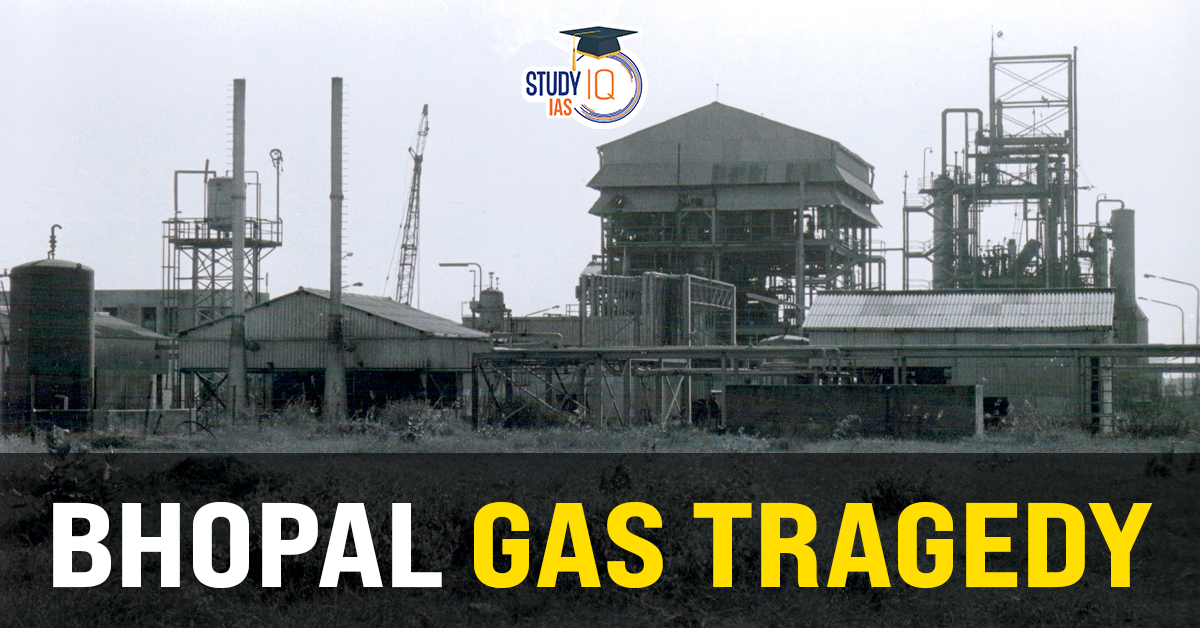Table of Contents
Context: The Madhya Pradesh government has initiated the process to dispose of 337 tonnes of toxic waste accumulated on the premises of Union Carbide India Ltd. (UCIL) in Bhopal.
About Disposal Process
- Location of Disposal: The waste will be transferred to a Treatment, Storage, and Disposal Facility (TSDF) in Pithampur, Dhar district, located around 250 km from Bhopal.
- Packaging process: The waste is being packed in airtight bags and loaded into 12 specially designed airtight containers.
- A dedicated 250-kilometer green corridor is being prepared to ensure the secure and smooth transportation of the waste.
- Supervisory Authorities: The disposal process is being overseen by the Central Pollution Control Board (CPCB) and the Madhya Pradesh Pollution Control Board (MPPCB).
About Bhopal Gas Tragedy
- It occurred on December 3, 1984, in Bhopal (Madhya Pradesh), when 45 tons of toxic methyl isocyanate gas leaked from a pesticide plant owned by Union Carbide India Limited (UCIL).
- It was India’s first major Chemical (industrial) disaster.
- The toxic waste at the UCIL premises remains largely untreated, with minimal progress in both waste disposal and reassessment.
- Numerous studies over the years have shown that groundwater in areas surrounding the factory is contaminated with heavy metals and toxic substances posing significant health risks, like Cancer.
About Methyl Isocyanate (CH3NCO)
- It is a colourless, flammable liquid that reacts with water to produce methylamine (MIC) and carbon dioxide, along with heat.
- It is toxic when inhaled, ingested or exposed to the skin or eyes. It’s also highly flammable and can be explosive when mixed with air.
| Other Major Chemical Disasters in India |
|
What Happened in Bhopal Gas Tragedy?
- The leak of methyl isocyanate (CH₃NCO) gas from UCIL’s pesticide plant released a deadly cloud over Bhopal.
- Over 3,000 people died immediately, with the death toll rising to 16,000–25,000 in subsequent years due to long-term exposure.
- The tragedy exposed gaps in industrial safety and the negligence of multinational corporations.
Impact of Bhopal Gas Tragedy
- Health Consequences:
- Acute symptoms: Breathlessness, vomiting, and severe eye irritation.
- Long-term effects: Cancer, birth defects, and respiratory and neurological disorders.
- Environmental Damage:
- Toxic waste remains untreated at the UCIL site.
- Groundwater contamination with heavy metals and toxic substances continues to pose severe health risks for nearby residents.
Legal and Environmental Aftermath
Despite several court cases and global attention:
- Compensation awarded to victims was inadequate.
- Waste disposal remains stagnant, with hazardous material still at the site.
- Activists and survivors continue to demand justice and environmental cleanup.
Other Major Chemical Disasters in India
1. Vizag Gas Leak (2020)
- Incident: Leakage of styrene gas from LG Polymers in Visakhapatnam.
- Impact: 12 deaths and over 1,000 affected by respiratory and neurological issues.
- Cause: Improper storage of the chemical during the COVID-19 lockdown.
2. Tughlakabad Gas Leak (2017)
- Incident: Leakage of chloro methylpyridine, a pesticide manufacturing chemical, from a container depot.
- Impact: Over 450 schoolchildren were hospitalized with symptoms like nausea and eye irritation.
- Cause: Lax handling of hazardous chemicals during storage and transport.
3. Ammonia Gas Leak at Chennai (2024)
- Incident: Cyclone Michaung damaged a pipeline, leading to the leakage of ammonia gas.
- Impact: Severe respiratory issues for residents and extensive environmental harm.
- Cause: Lack of infrastructure to withstand natural disasters in industrial areas.
Lessons from Bhopal and Subsequent Disasters
1. Importance of Industrial Safety
- Implementing advanced monitoring systems.
- Regular audits and maintenance of chemical plants.
2. Legal and Ethical Accountability
- Multinational corporations must adhere to local safety standards.
- Effective compensation mechanisms for affected individuals and communities.
3. Environmental Protection
- Proper disposal of hazardous waste.
- Long-term remediation of contaminated sites to prevent environmental degradation.
Conclusion
The Bhopal Gas Tragedy and other chemical disasters underline the urgent need for robust regulatory frameworks, corporate accountability, and environmental consciousness. India’s industrial growth must be aligned with safety and sustainability to prevent such tragedies in the future. Lessons from these disasters should serve as a wake-up call to strengthen disaster preparedness and protect lives, livelihoods, and the environment.


 Indus Water Treaty 1960 Suspended by Ind...
Indus Water Treaty 1960 Suspended by Ind...
 5 Years of SVAMITVA Scheme and Its Benef...
5 Years of SVAMITVA Scheme and Its Benef...
 Places in News for UPSC 2025 for Prelims...
Places in News for UPSC 2025 for Prelims...





















